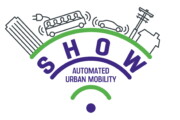SHared automation Operating models for Worldwide adoption

The aim of SHOW is to support a way towards sustainable urban transport with automated vehicles by means of technical solutions, business models and impact analyses. The deployment of connected, cooperative, electrified fleets of autonomous vehicles in coordinated Public Transport (PT), Demand Responsive Transport (DRT), Mobility as a Service (MaaS) and Logistics as a Service (LaaS) operational chains will be demonstrated in real-life urban environments in five Mega, six Satellite and three Follower Pilots.
By deploying a fleet of 74 SAE Level 4 automated vehicles of all kinds (buses, shuttles, pods, robo-taxis, automated vehicles in combination with MaaS and freight vehicles) used for passenger, freight and mixed traffic and connected to a variety of supporting infrastructures (5G, G5, IoT, etc.), the project aims to satisfy all urban automated mobility needs of users.
This project is realised by a consortium of 69 partners, six third parties and with the additional support of 60 stakeholders as well as twinning actions with eleven organisations in the US, South Korea, Australia, China, Taiwan and Singapore.
Megasite Austria
Austria is one of the five so-called mega sites where pilot tests will be carried out. The Austrian site consists of the cities Salzburg, Graz, Pörtschach and Klagenfurt and is coordinated by AustriaTech. The pilots in SHOW will last 12 months, during which a total of more than 1.5 million people and 350,000 goods will be transported by the automated vehicles.
Salzburg Pilot
Salzburg Research is responsible for the design and implementation of the pilot project in Salzburg, which is aimed at the user groups of commuters and city residents, day-trippers and tourists. Based on the experiences from the Digibus® Austria project, the pilot in Salzburg pursues the goal of testing an automated on-demand transport (automated DRT) to connect rural regions to intermodal mobility nodes in order to better bridge the first and last mile in public transport. The challenges in testing an automated DRT include topics such as MaaS integration, self-learning algorithms, seamless integration with automated and non-automated public transport, and C-ITS support for higher levels of automation.




